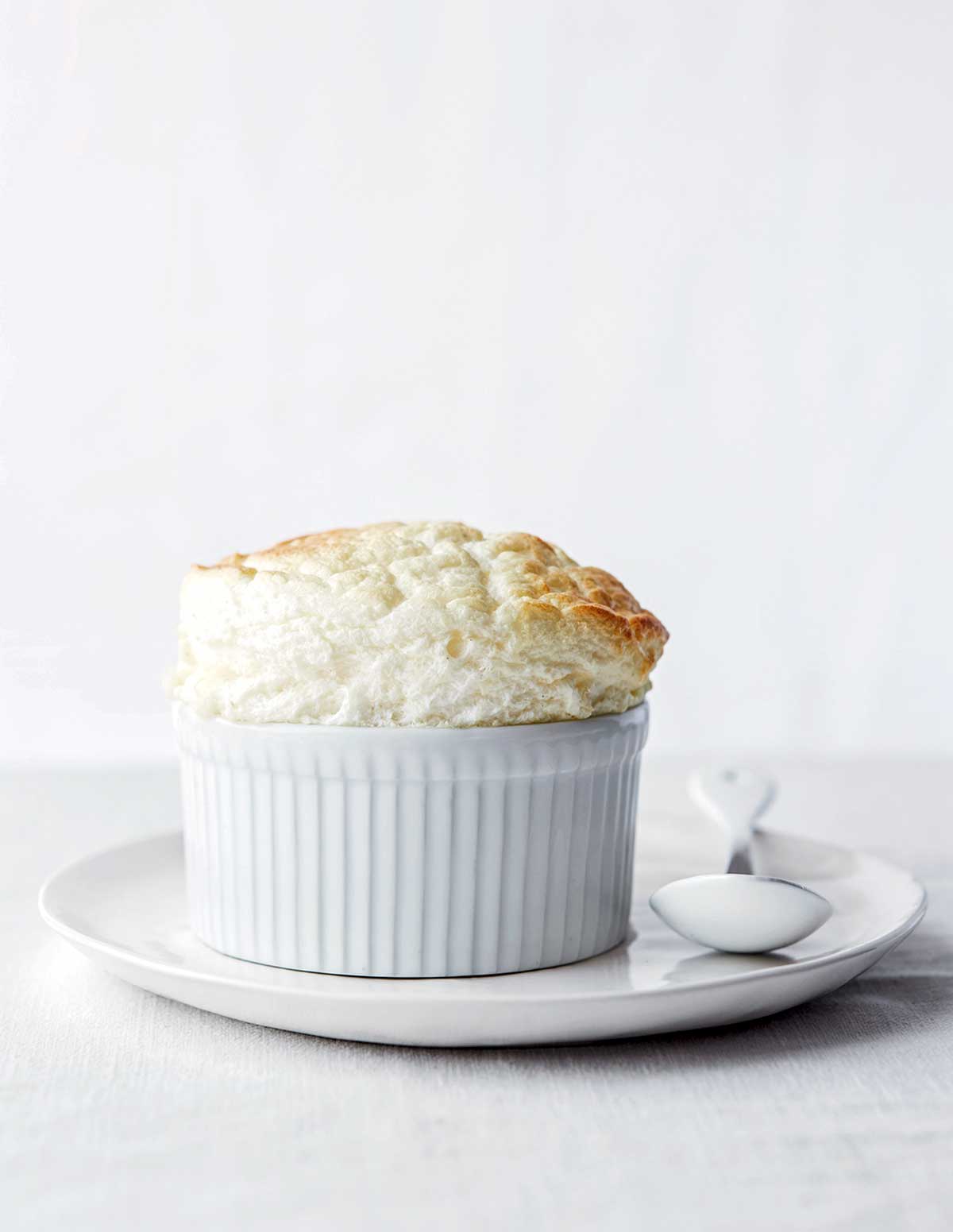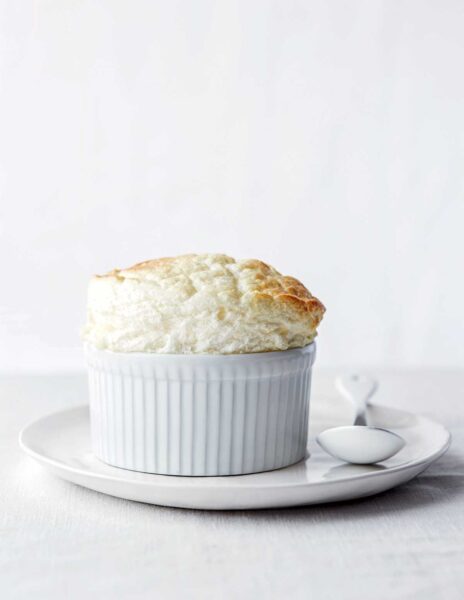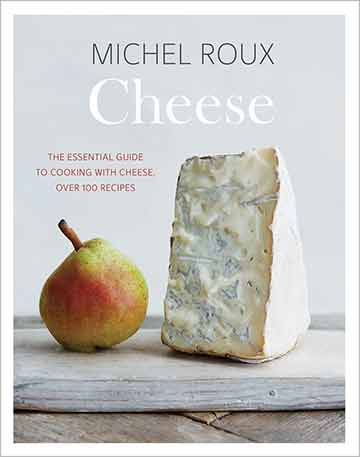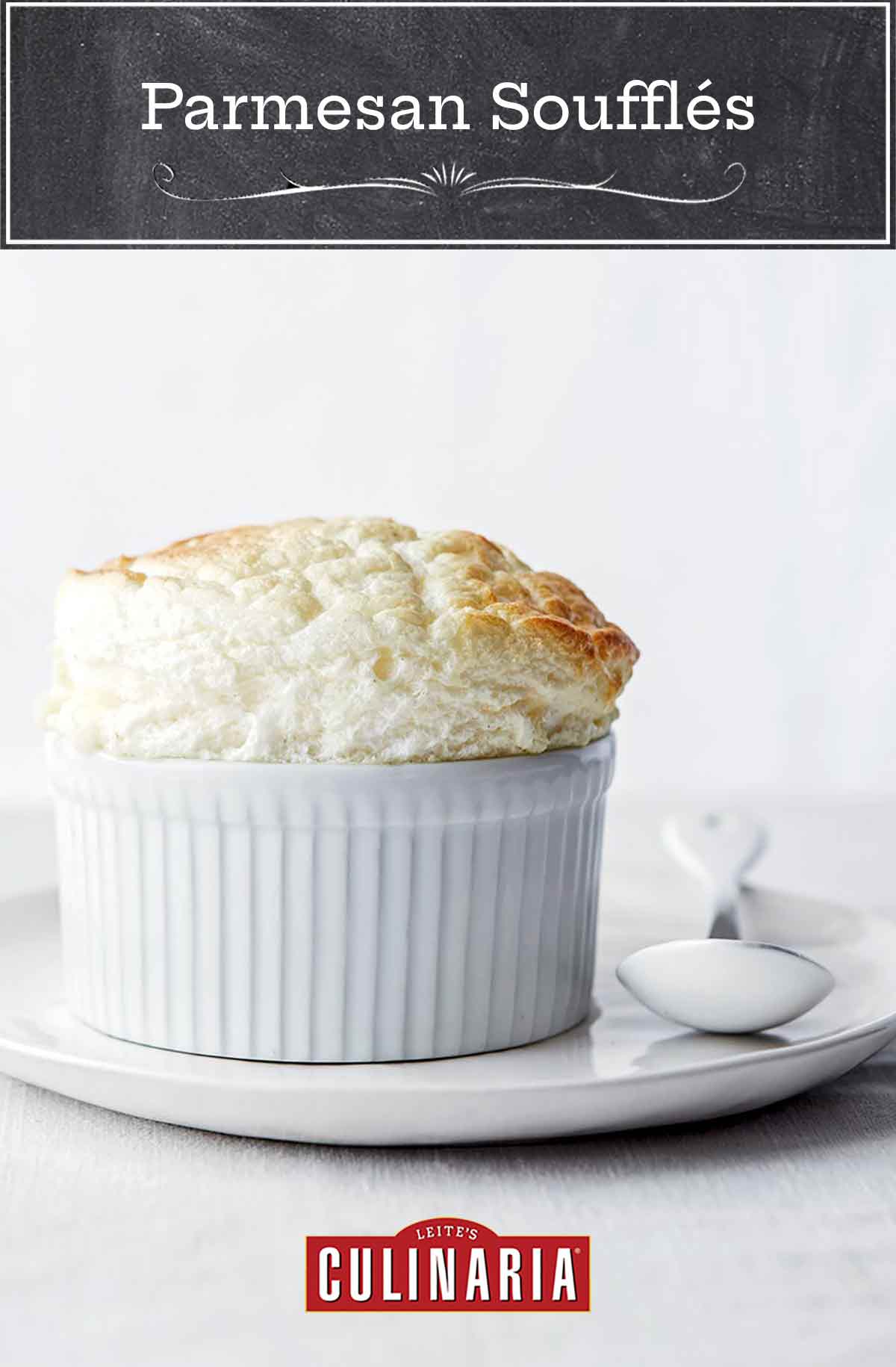
Lofty and lovely as can be. That’s what we think of these Parmesan souffles. They’re also a lot easier than you’d think to assemble and elegant as can be. We’re not certain when we like them most—breakfast, dinner, or anytime in between.–David Leite
Parmesan Soufflé FAQs
While we wouldn’t recommend throwing a novice into the kitchen and asking them to bake a souffle, the dish is really not as intimidating as you may imagine. There are a few key points to keep in mind to help set yourself up for success: prepare your souffle dishes before you begin working with any ingredients, pay attention to the recipe and timing, make sure your oven is at exactly the right temperature, and serve your success the moment it comes out of the oven. We’ve all had a soufflé fall and can make no promises about your initial success, but just remember that practice makes perfect, and we totally believe in you.
Yes! See the Cheddar soufflés variation at the bottom of this page for tips.
Easy. Heat your oven to 350°F and bake your soufflé for about 6 minutes. One of our testers used their toaster oven with great success.

Parmesan Soufflés
Equipment
- 8 individual soufflé dishes, preferably about 4 inches (10 cm) in diameter and 2 1/2 inches (6 cm) tall
Ingredients
For the dishes
- 3 to 5 tablespoons unsalted butter, softened
- 2 ounces Parmesan, freshly grated
For the soufflés
- 3 tablespoons unsalted butter
- 1/3 cup all-purpose flour
- 2 cups plus 1 tablespoon full-fat milk
- 2 pinches cayenne pepper
- 10 medium free-range eggs (divided), plus an extra 2 yolks
- 6 1/2 ounces Parmesan cheese, freshly grated
- Sea salt and freshly ground black pepper
Instructions
Prepare the dishes
- Generously butter 8 individual soufflé dishes, preferably about 4 inches (10 cm) in diameter and 2 1/2 inches (6 cm) tall. Add the grated Parmesan to one of the buttered dishes and then rotate the dish to coat the inside. Tilt the first soufflé dish over a second soufflé dish to let the excess drop into the second. Repeat this with the remaining dishes until they’re all coated.
Prepare the soufflés
- Melt the butter in a small pan over medium-low heat. Add the flour and cook, stirring with a small balloon whisk, for 2 minutes to make a roux. Gradually stir in the cold milk and bring to the boil over a medium heat. Simmer for 1 minute and then pour the béchamel into a bowl. Add a little salt and pepper as well as the cayenne and then whisk in the 12 egg yolks. Cover with plastic wrap and set aside in a warm place.
- Preheat the oven to 400°F (200°C).
- In a very clean bowl, whisk the 10 egg whites with a pinch of salt until semi-firm peaks form, about 8 minutes (or, if using a stand mixer with the whisk attachment, about 3 minutes. Without delay, whisk 1/3 of the egg whites into the warm béchamel. Now, using a spatula or large spoon in one hand, very gently fold in the rest of the egg whites while gradually showering in the grated Parmesan with your other hand. Stop mixing as soon as the mixture is combined, less than 1 minute.
- Using a spoon, generously fill each soufflé dish to 1/2 inch (12 mm) above the rim. Gently smooth the tops of the soufflés using the side of a knife and then run the tip of the knife around the inside of each rim to allow the souffle to get a good rise.
- Line the base of a roasting pan with parchment paper and place the soufflé dishes in the pan. Pull the rack partway out of the oven and pour enough near-boiling water into the roasting pan to come halfway up the soufflé dishes. Bake for 14 to 17 minutes, depending on the size of the ramekins, rotating the pan halfway through to ensure even cooking.
- Gently remove the pan from the oven and lift the soufflé dishes out onto warmed plates. Serve immediately.
Notes
Cheddar Soufflés Variation
For Cheddar soufflés, replace the Parmesan in the soufflé mixture with 7 ounces (200 g) Cheddar and use 3 ounces (85 g) for lining the dishes. For Gruyère or Comté soufflés, use 8 1/2 ounces (240 g) cheese for the mixture, and 3 ounces (85 g) for the dishes.
Explore More with AI
Nutrition
Nutrition information is automatically calculated, so should only be used as an approximation.
Recipe Testers’ Reviews
This was my first attempt at a savory soufflé and I wasn’t sure what to expect. It was delicious. It was light but crusty and filled with the wonderful Parmesan flavor (you will need to use a good Parmesan) and accentuated by two small pinches of cayenne pepper. And it was versatile. I made them for dinner one night and served them with a grilled New York Strip. The flavors complemented each other beautifully. But the next morning, I popped a leftover one in the toaster oven at 350°F while I brewed coffee and it made a wonderful breakfast. I cooked the soufflés for 11 minutes to get a lightly brown crust. I did only the Parmesan version and it was so good. This makes 8 soufflés but the men had two each with dinner.
Practice patience! Despite the simplest of ingredients and how rewarding they are, making soufflés paralyze me with fear and I talk myself out of making them. To get height and lightness, I knew I needed the lightest touch with the egg whites, and part of that is volume. A simple calculation would have said for TWO servings, 2 eggs and half a yolk (which is inconvenient and probably not as important as the weight or volume of the whites and yolks). I tried several variations (yard eggs, large store-bought, and extra-large store-bought eggs), and my FINAL best results were 3 whites and 2 yolks.
The Parmesan is just right in flavor along with a half a pinch of cayenne (my “pinch” measure looks to be 1/16 teaspoon) along with a couple of grinds of pepper and a scant pinch of kosher salt. I tried hand whisking (about 8 to 9 minutes and a sore shoulder) and moved to using my wire-whisked electric hand mixer, one I bought especially because it was well known for quickly putting air into whipped egg whites or cream. That happens in under a minute! I also tried both the recipe method of folding in the whites to the béchamel as well as letting the béchamel cool slightly and adding a portion of the Parmesan before the whites. In each case I measured and weighed the egg whites, seeing variation even in the same grade commercial eggs, roughly under a 1/2 cup, from 100g to 118g, and 130g with the extra large).
The butter for the ramekins seems excess, but the point really is to generously butter them. And the amount of freshly grated Parmesan is also generous for the ramekins, but weigh that out first, and use any extra for the soufflé (I was using 8 to 10g finely grated Parmesan on a Microplane box grater for the ramekins and 45g for the soufflé). Don’t worry if your ramekins are slightly different in size than the recipe specifies. Mine were 4 inches by 2 inches. The first time you make this, maybe prepare an extra ramekin if you think you might need it. I now feel confident I can walk into the house, turn on the oven and serve souffles in under an hour.
Immediately after turning on the oven, separate your cold eggs (cold eggs are easier to separate), placing the whites in the bowl you will whisk or beat them in so they can now come to room temp as you prepare the ramekins, grate your cheese and make the béchamel. if you are making this for two, your roux and béchamel are going to progress very quickly and I found that part was best done with either a small silicone spatula or a flat small whisk, in your tiniest saucepan. Stir and whisk constantly, drizzling in the milk slowly as you continue to incorporate the milk.
Most important, don’t panic. Even if you are not sure the first time you make these, you can pop them back in the oven if they are underdone. I definitely learned a lot after 5 batches, and once mastering it on a small scale. I can consider making it for a dinner party. Next mountain of egg whites maybe I will attempt chocolate or Grand Marnier soufflé like a favorite restaurant offered.
I divided the quantities of the ingredients in two, making half the amount given. My soufflé mix made 5 soufflés in the molds I used. The taste was good and perhaps needed just a little more salt. Overall the recipe gives good results and looks impressive.













